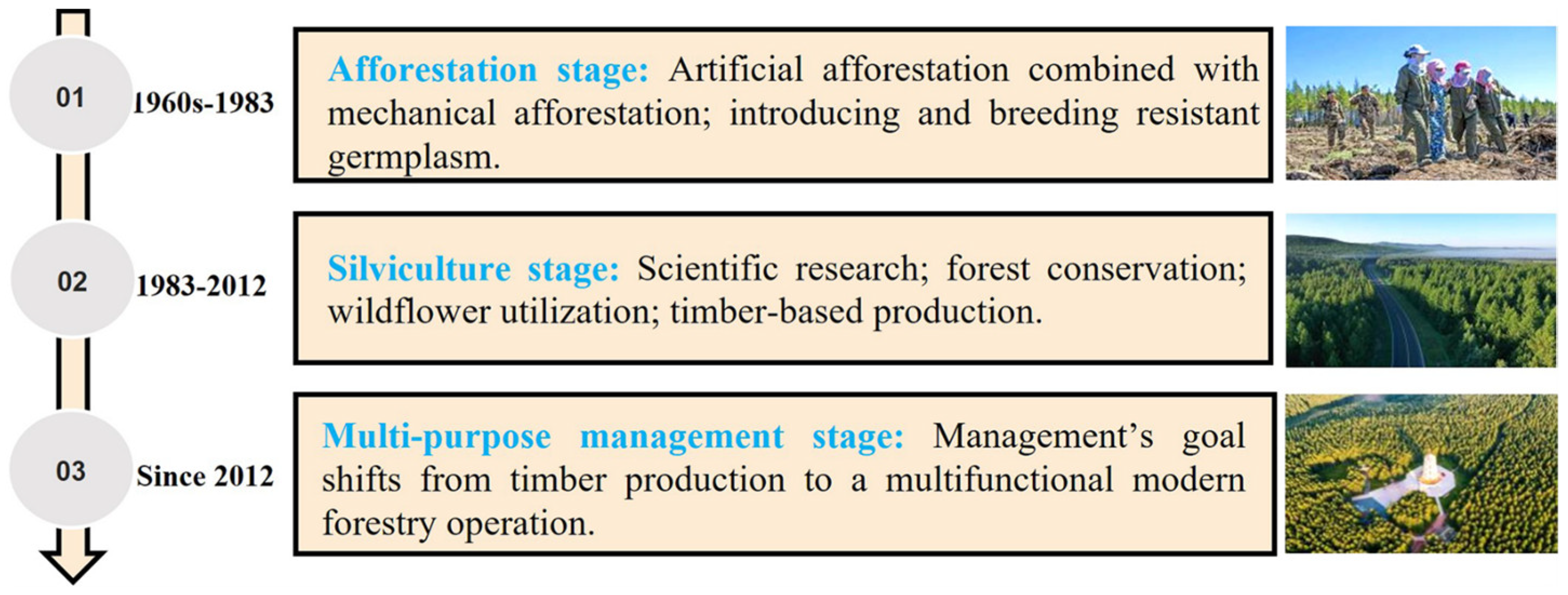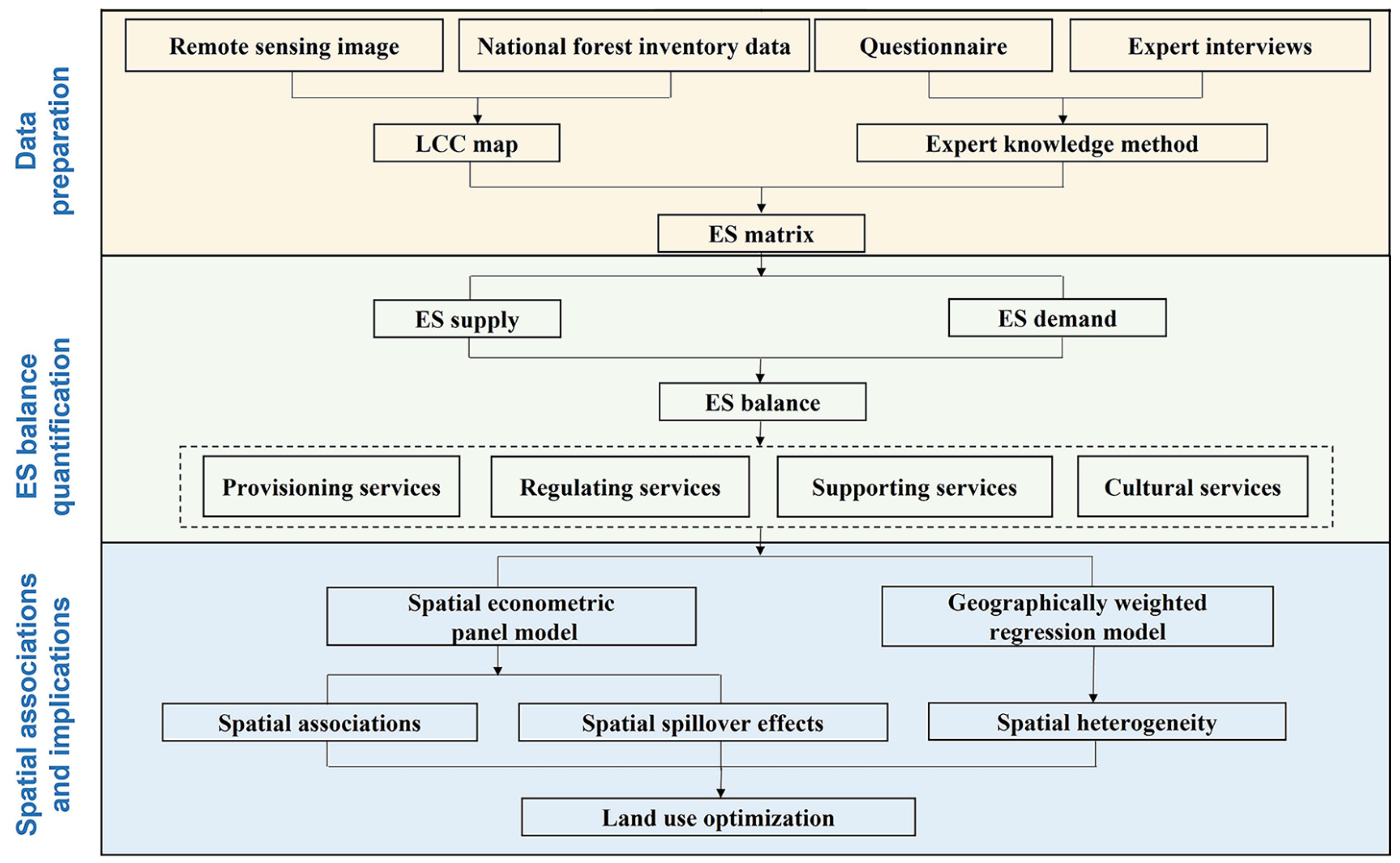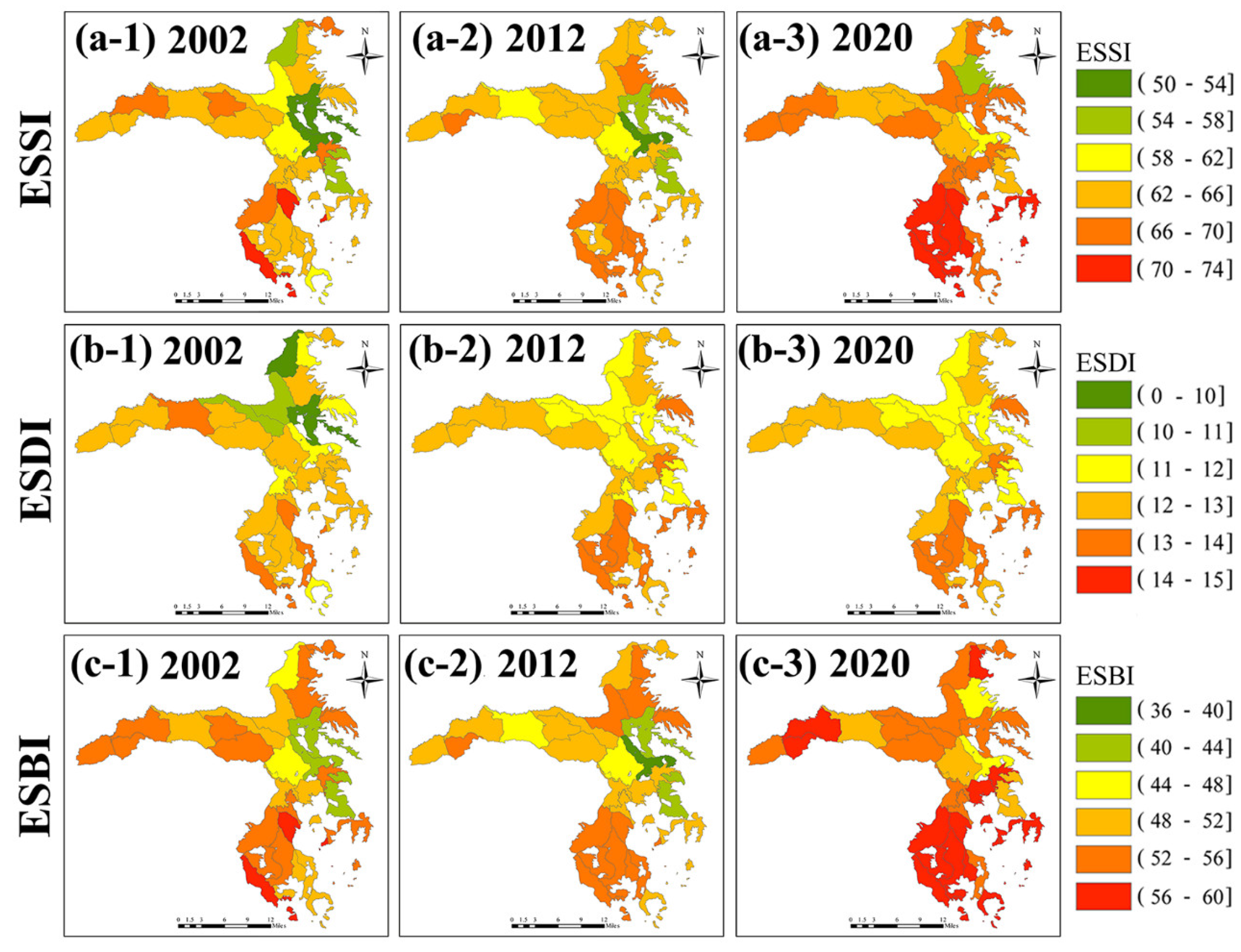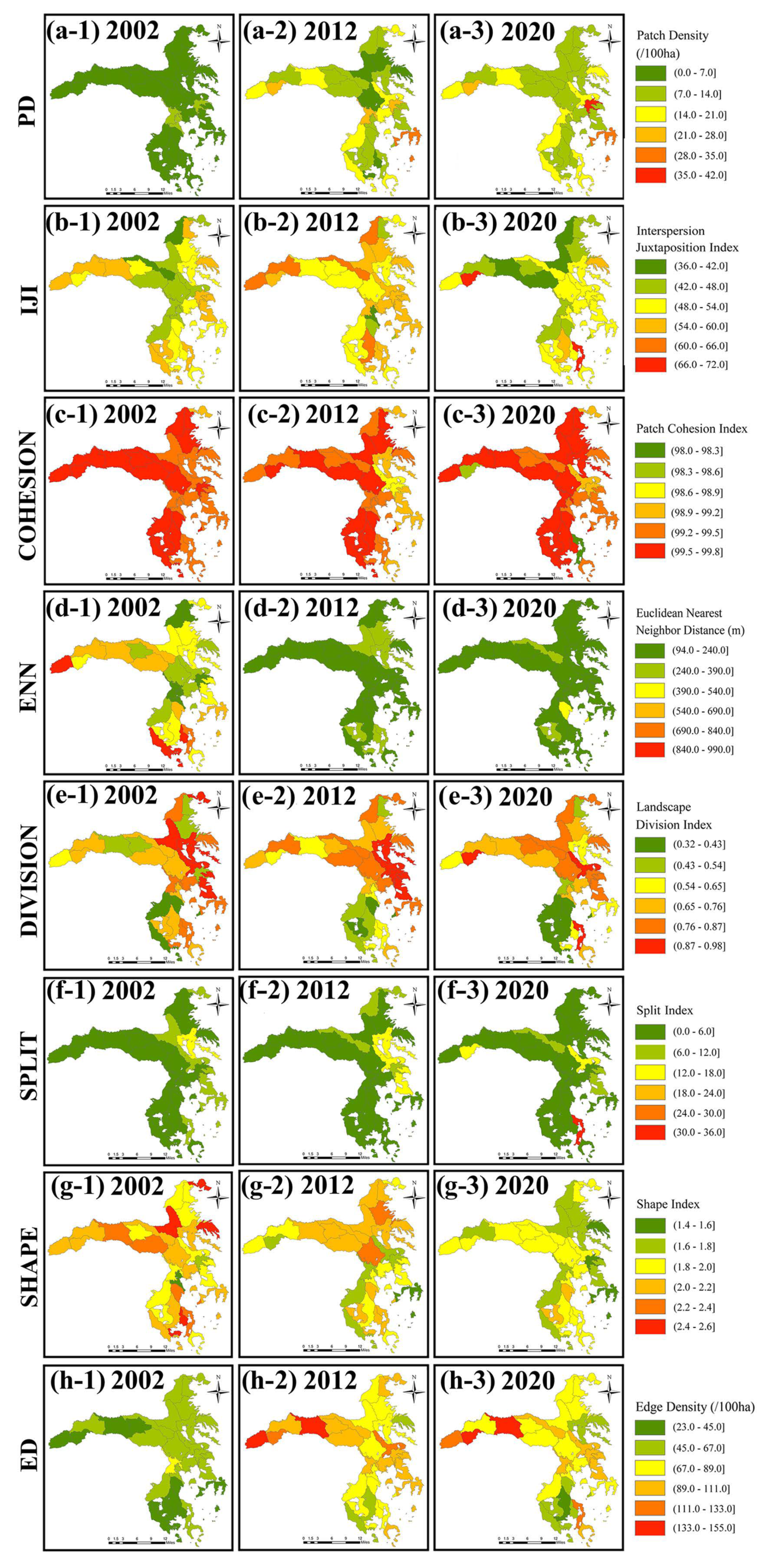Spatiotemporal Variations and Determinants of Supply–Demand Balance of Ecosystem Service in Saihanba Region, China
Abstract
:1. Introduction
2. Materials and Methods
2.1. Study Area
2.2. Conceptual Framework
2.3. Data and Methods
2.3.1. Data Collection and Preprocessing
2.3.2. Quantitative Assessment of the Relationship between ES Supply and Demand
2.3.3. Determining the Spatial Correlation between ES Balance and Its Driving Factors
3. Results
3.1. Spatiotemporal Variations of ES Balance, LUCC, and Landscape Patterns
3.2. Associations between ES Balance and LUCC, Landscape Pattern, and Socioeconomic Indicators
3.2.1. Correlation Analysis between ES Balance and LUCC
3.2.2. Correlation between ES Indices and Landscape and Socioeconomic Variables
4. Discussion
4.1. Spatial Association between the ES Balance and LUCC
4.2. Spatial Association of the ES Balance with Landscape and Socioeconomic Variables
4.3. Considering Spatial Heterogeneity and Spillover Effects into ES Decision—Making
4.4. Limitations of the Current Studies and Future Research Directions
5. Conclusions
Supplementary Materials
Author Contributions
Funding
Data Availability Statement
Acknowledgments
Conflicts of Interest
References
- Moreno–Mateos, D.; Alberdi, A.; Morriën, E.; van der Putten, W.H.; Rodríguez–Uña, A.; Montoya, D. The long–term restoration of ecosystem complexity. Nat. Ecol. Evol. 2020, 4, 676–685. [Google Scholar] [CrossRef] [PubMed]
- Kuuluvainen, T. Forest management and biodiversity conservation based on natural ecosystem dynamics in Northern Europe: The complexity challenge. AMBIO 2009, 38, 309–315. [Google Scholar] [CrossRef] [PubMed]
- Tan, P.Y.; Zhang, J.Y.; Masoudi, M.; Alemu, J.B.; Edwards, P.J.; Grêt–Regamey, A.; Richards, D.R.; Saunders, J.; Song, X.P.; Wong, L.W. A conceptual framework to untangle the concept of urban ecosystem services. Landsc. Urban Plan. 2020, 200, 103837. [Google Scholar] [CrossRef]
- Hallberg–Sramek, I.; Nordström, E.–M.; Priebe, J.; Reimerson, E.; Mårald, E.; Nordin, A. Combining scientific and local knowledge improves evaluating future scenarios of forest ecosystem services. Ecosyst. Serv. 2023, 60, 101512. [Google Scholar] [CrossRef]
- Li, L.M.; Tang, H.N.; Lei, J.R.; Song, X.Q. Spatial autocorrelation in land use type and ecosystem service value in Hainan Tropical Rain Forest National Park. Ecol. Indic. 2022, 137, 108727. [Google Scholar] [CrossRef]
- Hanna, D.E.L.; Raudsepp-Hearne, C.; Bennett, E.M. Effects of land use, cover, and protection on stream and riparian ecosystem services and biodiversity. Conserv. Biol. 2020, 34, 244–255. [Google Scholar] [CrossRef] [PubMed]
- Brockerhoff, E.G.; Barbaro, L.; Castagneyrol, B.; Forrester, D.I.; Gardiner, B.; González–Olabarria, J.R.; Lyver, P.O.; Meurisse, N.; Oxbrough, A.; Taki, H.; et al. Forest biodiversity, ecosystem functioning and the provision of ecosystem services. Biodivers. Conserv. 2017, 26, 3005–3035. [Google Scholar] [CrossRef]
- Wang, D.; Liang, Y.J.; Peng, S.Z.; Yin, Z.C.; Huang, J.J. Integrated assessment of the supply–demand relationship of ecosystem services in the Loess Plateau during 1992–2015. Ecosyst. Health Sustain. 2022, 8, 2130093. [Google Scholar] [CrossRef]
- Chen, Y.M.; Zhai, Y.P.; Gao, J.X. Spatial patterns in ecosystem services supply and demand in the Jing–Jin–Ji region, China. J. Clean. Prod. 2022, 361, 132177. [Google Scholar] [CrossRef]
- Huang, F.X.; Zuo, L.Y.; Gao, J.B.; Jiang, Y.; Du, F.J.; Zhang, Y.B. Exploring the driving factors of trade–offs and synergies among ecological functional zones based on ecosystem service bundles. Ecol. Indic. 2023, 146, 109827. [Google Scholar] [CrossRef]
- Zhang, S.D.; Wu, T.; Guo, L.; Zou, H.T.; Shi, Y. Integrating ecosystem services supply and demand on the Qinghai–Tibetan Plateau using scarcity value assessment. Ecol. Indic. 2023, 147, 109969. [Google Scholar] [CrossRef]
- Wei, W.; Nan, S.X.; Xie, B.B.; Liu, C.F.; Zhou, J.J.; Liu, C.Y. The spatial–temporal changes of supply–demand of ecosystem services and ecological compensation: A case study of Hexi Corridor, Northwest China. Ecol. Eng. 2023, 187, 106861. [Google Scholar] [CrossRef]
- Wang, Y.Q.; Huang, H.P.; Yang, G.; Chen, W. Ecosystem service function supply–demand evaluation of urban functional green space based on multi–source data fusion. Remote. Sens. 2023, 15, 118. [Google Scholar] [CrossRef]
- Wu, J.S.; Jin, X.R.; Wang, H.; Feng, Z. Evaluating the supply–demand balance of cultural ecosystem services with budget ex–pectation in Shenzhen, China. Ecol. Indic. 2022, 142, 109165. [Google Scholar] [CrossRef]
- Zhao, C.; Xiao, P.N.; Qian, P.; Xu, J.; Yang, L.; Wu, Y.X. Spatiotemporal differentiation and balance pattern of ecosystem service supply and demand in the Yangtze River Economic Belt. Int. J. Environ. Res. Public Health 2022, 19, 7223. [Google Scholar] [CrossRef] [PubMed]
- Wu, X.; Liu, S.L.; Zhao, S.; Hou, X.Y.; Xu, J.W.; Dong, S.K.; Liu, G.H. Quantification and driving force analysis of ecosystem services supply, demand and balance in China. Sci. Total Environ. 2019, 652, 1375–1386. [Google Scholar] [CrossRef]
- Burkhard, B.; Kroll, F.; Nedkov, S.; Müller, F. Mapping ecosystem service supply, demand and budgets. Ecol. Indic. 2012, 21, 17–29. [Google Scholar] [CrossRef]
- Staes, J.; Broekx, S.; Van Der Biest, K.; Vrebos, D.; Olivier, B.; De Nocker, L.; Liekens, I.; Poelmans, L.; Verheyen, K.; Jeroen, P.; et al. Quantification of the potential impact of nature conservation on ecosystem services supply in the Flemish Region: A cascade modelling approach. Ecosyst. Serv. 2017, 24, 124–137. [Google Scholar] [CrossRef]
- Zhao, Y.H.; Wang, N.; Luo, Y.H.; He, H.S.; Wu, L.; Wang, H.L.; Wang, Q.T.; Wu, J.S. Quantification of ecosystem services supply–demand and the impact of demographic change on cultural services in Shenzhen, China. J. Environ. Manag. 2022, 304, 114280. [Google Scholar] [CrossRef]
- Yang, M.H.; Zhao, X.N.; Wu, P.T.; Hu, P.; Gao, X.D. Quantification and spatially explicit driving forces of the incoordination between ecosystem service supply and social demand at a regional scale. Ecol. Indic. 2022, 137, 108764. [Google Scholar] [CrossRef]
- Villa, F.; Bagstad, K.J.; Voigt, B.; Johnson, G.W.; Portela, R.; Honzák, M.; Batker, D. A Methodology for Adaptable and Robust Ecosystem Services Assessment. PLoS ONE 2014, 9, e91001. [Google Scholar] [CrossRef]
- Huang, K.X.; Peng, L.; Wang, X.H.; Deng, W. Integrating circuit theory and landscape pattern index to identify and optimize ecological networks: A case study of the Sichuan Basin, China. Environ. Sci. Pollut. Res. 2022, 29, 66874–66887. [Google Scholar] [CrossRef]
- Wilkerson, M.L.; Mitchell, M.G.E.; Shanahan, D.; Wilson, K.A.; Ives, C.D.; Lovelock, C.E.; Rhodes, J.R. The role of so–cio–economic factors in planning and managing urban ecosystem services. Ecosyst. Serv. 2018, 31, 102–110. [Google Scholar] [CrossRef]
- Chen, S.L.; Liu, X.T.; Yang, L.; Zhu, Z.H. Variations in ecosystem service value and its driving factors in the Nanjing Metro–politan Area of China. Forests 2023, 14, 113. [Google Scholar] [CrossRef]
- Liu, J.; Xu, Q.L.; Yi, J.H.; Huang, X. Analysis of the heterogeneity of urban expansion landscape patterns and driving factors based on a combined Multi–Order Adjacency Index and Geodetector model. Ecol. Indic. 2022, 136, 108655. [Google Scholar] [CrossRef]
- Chen, W.L.; Jiang, C.; Wang, Y.X.; Liu, X.D.; Dong, B.B.; Yang, J.; Huang, W.M. Landscape patterns and their spatial associ–ations with ecosystem service balance: Insights from a rapidly urbanizing coastal region of southeastern China. Front. Env. Sci. 2022, 10, 1–20. [Google Scholar] [CrossRef]
- Zhang, Z.; Wang, Y.Y.; Wang, Z.X. A Grey–TOPSIS method based on weighted relational coefficient. J. Grey Syst. 2014, 26, 112–123. [Google Scholar]
- Liu, L.T.; Yu, S.C.; Zhang, H.J.; Wang, Y.; Liang, C. Analysis of land use change drivers and simulation of different future scenarios: Taking Shanxi Province of China as an example. Int. J. Environ. Res. Public Health 2023, 20, 1626. [Google Scholar] [CrossRef]
- Dong, X.S.; Yuan, Q.Z.; Kou, Y.W.; Li, S.J.; Ren, P. Distribution and ecological network construction of national natural pro–tected areas in the upper reaches of Yangtze River. Sustainability 2023, 15, 1012. [Google Scholar] [CrossRef]
- Chen, X.; Du, X.; Liu, W.; Wu, M.; Zhang, X. Analysis on restoration impact value model of Saihanba Forest Farm. Int. Core J. Eng. 2022, 8, 88–94. [Google Scholar] [CrossRef]
- Wang, S.; Gui, Y.; Xu, X.; Liu, H. Saihanba–ecological protection construction and its impact evaluation on the environment. Acad. J. Environ. Earth Sci. 2022, 4, 32–37. [Google Scholar] [CrossRef]
- Li, B.; Zhang, S.; Wang, S.; Ning, L.; Wang, L. Research on the evaluation model of the ecological impact of the Saihanba based on multiple regression. Environ. Resour. Ecol. J. 2021, 5, 39–43. [Google Scholar] [CrossRef]
- Liu, B.; Zhang, K.; Luo, H. Evaluation of Saihanba environmental treatment based on Entropy Method. Int. Core J. Eng. 2022, 8, 393–396. [Google Scholar] [CrossRef]
- Yuming, L. Natural Reserve and Ecological Conservation Zone. In The Great Wall in Beijing; EDP Sciences: Les Ulis, France, 2022; pp. 146–156. [Google Scholar]
- Sun, J.; Li, Y. Remote sensing monitoring of afforestation and its interaction with climate in Saihanba Mechanical Forest Farm in recent 45 years. In Proceedings of the 6th International Conference on Computer Science and Application Engineering, Virtual, 21–23 October 2022; pp. 1–7. [Google Scholar]
- Wang, Z. Ecosystem evaluation and prediction based on Saihanba. Environ. Resour. Ecol. J. 2021, 5, 44–49. [Google Scholar] [CrossRef]
- Wang, J.; Zhai, T.; Lin, Y.; Kong, X.; He, T. Spatial imbalance and changes in supply and demand of ecosystem services in China. Sci. Total Environ. 2019, 657, 781–791. [Google Scholar] [CrossRef] [PubMed]
- Jiang, C.; Yang, Z.; Wen, M.; Huang, L.; Liu, H.; Wang, J.; Chen, W.; Zhuang, C. Identifying the spatial disparities and de–terminants of ecosystem service balance and their implications on land use optimization. Sci. Total Environ. 2021, 793, 148472. [Google Scholar] [CrossRef] [PubMed]
- Vadell, E.; de-Miguel, S.; Pemán, J. Large–scale reforestation and afforestation policy in Spain: A historical review of its un–derlying ecological, socioeconomic and political dynamics. Land Use Policy 2016, 55, 37–48. [Google Scholar] [CrossRef]
- Doelman, J.C.; Stehfest, E.; van Vuuren, D.P.; Tabeau, A.; Hof, A.F.; Braakhekke, M.C.; Gernaat, D.E.H.J.; Berg, M.v.D.; van Zeist, W.; Daioglou, V.; et al. Afforestation for climate change mitigation: Potentials, risks and trade-offs. Glob. Chang. Biol. 2020, 26, 1576–1591. [Google Scholar] [CrossRef]
- Yi, Y.; Liu, H.; Xu, Q.; Yang, Z. The relationship between ecosystem service supply and demand in plain areas undergoing urbanization: A case study of China’s Baiyangdian Basin. J. Env. Manag. 2021, 289, 112492. [Google Scholar] [CrossRef]
- Jiang, M.; Jiang, C.; Huang, W.; Chen, W.; Gong, Q.; Yang, J.; Zhao, Y.; Zhuang, C.; Wang, J.; Yang, Z. Quantifying the sup–ply–demand balance of ecosystem services and identifying its spatial determinants: A case study of ecosystem restoration hotspot in Southwest China. Ecol. Eng. 2022, 174, 106472. [Google Scholar] [CrossRef]
- Wu, J.; Guo, X.; Zhu, Q.; Guo, J.; Han, Y.; Zhong, L.; Liu, S. Threshold effects and supply–demand ratios should be considered in the mechanisms driving ecosystem services. Ecol. Indic. 2022, 142, 109281. [Google Scholar] [CrossRef]
- Cao, S. Impact of China’s large–scale ecological restoration program on the environment and society in arid and semiarid areas of China: Achievements, problems, synthesis, and applications. Crit. Rev. Env. Sci. Technol. 2011, 41, 317–335. [Google Scholar] [CrossRef]
- Burkhard, B.; Kandziora, M.; Hou, Y.; Müller, F. Ecosystem service potentials, flows and demands–concepts for spatial locali–sation, indication and quantification. Landsc. Online 2014, 34, 1–32. [Google Scholar] [CrossRef]
- Su, S.; Xiao, R.; Jiang, Z.; Zhang, Y. Characterizing landscape pattern and ecosystem service value changes for urbanization impacts at an eco–regional scale. Appl. Geogr. 2012, 34, 295–305. [Google Scholar] [CrossRef]
- Venerandi, A.; Quattrone, G.; Capra, L. A scalable method to quantify the relationship between urban form and socio–economic indexes. EPJ Data Sci. 2018, 7, 4. [Google Scholar] [CrossRef]
- Kupfer, J.A. Landscape ecology and biogeography: Rethinking landscape metrics in a post–FRAGSTATS landscape. Prog. Phys. Geogr. 2012, 36, 400–420. [Google Scholar] [CrossRef]
- Brunsdon, C.; Fotheringham, S.; Charlton, M. Geographically weighted regression. J. R. Stat. Soc. Ser. D Stat. 1998, 47, 431–443. [Google Scholar] [CrossRef]
- Hurvich, C.M.; Simonoff, J.S.; Tsai, C. –L. Smoothing Parameter Selection in Nonparametric Regression Using an Improved Akaike Information Criterion. J. Roy. Stat. Soc. B 1998, 60, 271–293. [Google Scholar] [CrossRef]
- Moran, P.A. Notes on continuous stochastic phenomena. Biometrika 1950, 37, 17–23. [Google Scholar] [CrossRef]
- Zhang, X.; Ning, X.; Wang, H.; Liu, Y.; Zhang, W. Quantitative assessment of the risk of human activities on landscape fragmentation: A case study of Northeast China Tiger and Leopard National Park. Sci. Total Environ. 2022, 851, 158413. [Google Scholar] [CrossRef]
- Zhang, Y.; Yin, H.; Zhu, L.; Miao, C. Landscape Fragmentation in Qinling–Daba Mountains Nature Reserves and Its Influencing Factors. Land 2021, 10, 1124. [Google Scholar] [CrossRef]
- Ostad–Ali–Askari, K. Review of the effects of the anthropogenic on the wetland environment. Appl. Water Sci. 2022, 12, 260. [Google Scholar] [CrossRef]
- Babu, A. Review of the role of the landscape approach in biodiversity conservation. Sustain. Biodivers. Conserv. 2023, 2, 61–86. [Google Scholar] [CrossRef]
- Mouchet, M.; Paracchini, M.–L.; Schulp, C.; Stürck, J.; Verkerk, P.; Verburg, P.; Lavorel, S. Bundles of ecosystem (dis)services and multifunctionality across European landscapes. Ecol. Indic. 2017, 73, 23–28. [Google Scholar] [CrossRef]
- Zhang, H.; Jiang, C.; Wang, Y.; Zhao, Y.; Gong, Q.; Wang, J.; Yang, Z. Linking land degradation and restoration to ecosystem services balance by identifying landscape drivers: Insights from the globally largest loess deposit area. Environ. Sci. Pollut. Res. 2022, 29, 83347–83364. [Google Scholar] [CrossRef]
- Pickett, S.T.; Cadenasso, M.L. Landscape Ecology: Spatial Heterogeneity in Ecological Systems. Science 1995, 269, 331–334. [Google Scholar] [CrossRef]
- Xie, X.; Wang, X.; Wang, Z.; Lin, H.; Xie, H.; Shi, Z.; Hu, X.; Liu, X. Influence of Landscape Pattern Evolution on Soil Conservation in a Red Soil Hilly Watershed of Southern China. Sustainability 2023, 15, 1612. [Google Scholar] [CrossRef]
- Li, Y.; Geng, H. Evolution of Land Use Landscape Patterns in Karst Watersheds of Guizhou Plateau and Its Ecological Security Evaluation. Land 2022, 11, 2225. [Google Scholar] [CrossRef]
- Boerema, A.; Rebelo, A.J.; Bodi, M.B.; Esler, K.J.; Meire, P. Are ecosystem services adequately quantified? J. Appl. Ecol. 2017, 54, 358–370. [Google Scholar] [CrossRef]
- Chen, W.; Chi, G.; Li, J. The spatial aspect of ecosystem services balance and its determinants. Land Use Policy 2020, 90, 104263. [Google Scholar] [CrossRef]
- Yuan, Y.; Chen, D.; Wu, S.; Mo, L.; Tong, G.; Yan, D. Urban sprawl decreases the value of ecosystem services and intensifies the supply scarcity of ecosystem services in China. Sci. Total Environ. 2019, 697, 134170. [Google Scholar] [CrossRef] [PubMed]
- Sun, X.; Tang, H.; Yang, P.; Hu, G.; Liu, Z.; Wu, J. Spatiotemporal patterns and drivers of ecosystem service supply and demand across the conterminous United States: A multiscale analysis. Sci. Total Environ. 2020, 703, 135005. [Google Scholar] [CrossRef] [PubMed]
- Luck, M.A.; Jenerette, G.D.; Wu, J.; Grimm, N.B. The urban funnel model and the spatially heterogeneous ecological footprint. Ecosystems 2001, 4, 782–796. [Google Scholar] [CrossRef]










| Variables | Mean Value | SD | Maximum | Minimum | VIF | Moran’s I |
|---|---|---|---|---|---|---|
| ESBI | 52.337 | 2.724 | 57.531 | 45.965 | −0.115 * | |
| ESSI | 67.607 | 3.299 | 56.958 | 73.125 | 0.331 ** | |
| ESDI | 12.914 | 0.602 | 11.463 | 14.108 | −0.236 * | |
| Forest stock volume | 3174.627 | 1834.431 | 6914.122 | 309.041 | 3.214 | 0.378 ** |
| PD | 10.305 | 4.413 | 24.267 | 5.441 | 1.914 | 0.356 *** |
| IJI | 52.043 | 4.085 | 63.059 | 45.585 | 2.168 | 0.378 *** |
| COHESION | 99.436 | 0.232 | 99.746 | 98.918 | 9.108 | 0.117 |
| DIVISION | 0.687 | 0.146 | 0.919 | 0.372 | 4.639 | 0.014 * |
| SPLIT | 4.976 | 3.244 | 13.562 | 1.594 | 5.298 | 0.173 * |
| SHAPE | 5.134 | 17.203 | 97.776 | 1.622 | 2.606 | 0.387 *** |
| ENN | 277.971 | 83.673 | 461.424 | 133.239 | 2.157 | −0.108 |
| ED | 47.552 | 10.074 | 78.381 | 23.253 | 2.002 | 0.295 *** |
| Independent Variables | SLPM–STPFE | SEPM–STPFE | SDPM–SFE | SDPM–TPFE | SDPM–STPFE |
|---|---|---|---|---|---|
| Forest stock volume | 0.001 * | 0.001 * | 0.001 * | 0.000 | 0.004 *** |
| PD | 0.532 | 0.141 * | 0.127 | 0.083 | 0.041 |
| IJI | 0.064 * | 0.186 *** | 0.326 *** | 0.035 | 0.768 *** |
| COHESION | −16.556 | 1.243 | 19.481 * | −11.005 *** | 50.293 *** |
| DIVISION | 9.644 ** | 1.951 | 3.880 | 10.862 ** | 16.364 ** |
| SPLIT | −0.613 | −0.192 | 1.461 ** | −0.858 *** | 4.912 *** |
| SHAPE | 3.507 * | −0.006 | 0.015 | −0.001 | 0.022 ** |
| ENN | −0.004 | −0.005 * | −0.008 *** | 0.001 | −0.010 *** |
| ED | 0.069 | 0.083 ** | 0.146 *** | 0.008 | 0.312 *** |
| W–Forest stock volume | 0.0001 | 0.000 | 0.0003 | ||
| W–PD | 0.147 * | −0.105 * | −0.054 | ||
| W–IJI | 0.106 * | −0.018 | 0.319 *** | ||
| W–COHESION | 9.093 ** | 0.021 | 15.957 *** | ||
| W–DIVISION | −1.815 | −3.017 * | −12.244 *** | ||
| W–SPLIT | 0.951 *** | 0.332 ** | 2.193 *** | ||
| W–SHAPE | 0.030 *** | −0.006 | 0.041 *** | ||
| W–ENN | 0.003 ** | 0.000 | 0.002 | ||
| W–ED | 0.013 | 0.030 * | 0.001 | ||
| R2 | 0.003 | 0.003 | 0.006 | 0.005 | 0.007 |
| Log–likelihood | −67.084 | −0.083 | −183.957 | −246.376 | −174.574 |
| Independent Variables | Direct Effects | Indirect Effects | Total Effects |
|---|---|---|---|
| Forest stock volume | 0.000 * | −0.009 * | −0.009 * |
| PD | 0.057 * | 1.297 * | 1.354 |
| IJI | −0.011 | −0.527 | −0.538 |
| COHESION | 5.760 * | 47.719 *** | 53.479 *** |
| DIVISION | 19.959 | 115.727 *** | 135.686 *** |
| SPLIT | 4.956 * | 23.081 ** | 28.037 ** |
| SHAPE | −0.037 | −0.121 | −0.159 |
| ENN | −0.002 | 0.051 ** | 0.0493 |
| ED | 0.428 ** | 1.755 *** | 2.184 *** |
Disclaimer/Publisher’s Note: The statements, opinions and data contained in all publications are solely those of the individual author(s) and contributor(s) and not of MDPI and/or the editor(s). MDPI and/or the editor(s) disclaim responsibility for any injury to people or property resulting from any ideas, methods, instructions or products referred to in the content. |
© 2023 by the authors. Licensee MDPI, Basel, Switzerland. This article is an open access article distributed under the terms and conditions of the Creative Commons Attribution (CC BY) license (https://creativecommons.org/licenses/by/4.0/).
Share and Cite
Liu, C.; Xu, L.; Li, D.; Huang, Y.; Kang, J.; Peng, B.; Huang, X.; Zhang, Z. Spatiotemporal Variations and Determinants of Supply–Demand Balance of Ecosystem Service in Saihanba Region, China. Forests 2023, 14, 1100. https://doi.org/10.3390/f14061100
Liu C, Xu L, Li D, Huang Y, Kang J, Peng B, Huang X, Zhang Z. Spatiotemporal Variations and Determinants of Supply–Demand Balance of Ecosystem Service in Saihanba Region, China. Forests. 2023; 14(6):1100. https://doi.org/10.3390/f14061100
Chicago/Turabian StyleLiu, Chong, Liren Xu, Donglin Li, Yinran Huang, Jiemin Kang, Bo Peng, Xuanrui Huang, and Zhidong Zhang. 2023. "Spatiotemporal Variations and Determinants of Supply–Demand Balance of Ecosystem Service in Saihanba Region, China" Forests 14, no. 6: 1100. https://doi.org/10.3390/f14061100
APA StyleLiu, C., Xu, L., Li, D., Huang, Y., Kang, J., Peng, B., Huang, X., & Zhang, Z. (2023). Spatiotemporal Variations and Determinants of Supply–Demand Balance of Ecosystem Service in Saihanba Region, China. Forests, 14(6), 1100. https://doi.org/10.3390/f14061100





